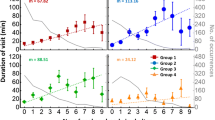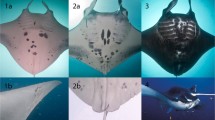Abstract
Interest in animal personalities has generated a burgeoning literature on repeatability in individual traits such as boldness or exploration through time or across different contexts. Yet, repeatability can be influenced by the interactive social strategies of individuals, for example, consistent inter-individual variation in aggression is well documented. Previous work has largely focused on the social aspects of repeatability in animal behaviour by testing individuals in dyadic pairings. Under natural conditions, individuals interact in a heterogeneous polyadic network. However, the extent to which there is repeatability of social traits at this higher order network level remains unknown. Here, we provide the first empirical evidence of consistent and repeatable animal social networks. Using a model species of shark, a taxonomic group in which repeatability in behaviour has yet to be described, we repeatedly quantified the social networks of ten independent shark groups across different habitats, testing repeatability in individual network position under changing environments. To understand better the mechanisms behind repeatable social behaviour, we also explored the coupling between individual preferences for specific group sizes and social network position. We quantify repeatability in sharks by demonstrating that despite changes in aggregation measured at the group level, the social network position of individuals is consistent across treatments. Group size preferences were found to influence the social network position of individuals in small groups but less so for larger groups suggesting network structure, and thus, repeatability was driven by social preference over aggregation tendency.



Similar content being viewed by others
References
Aplin LM, Farine DR, Morand-Ferron J, Cole EF, Cockburn A, Sheldon BC (2013) Individual personalities predict social behaviour in wild networks of great tits (Parus major). Ecol Lett 16:1365–1372
Barber I, Wright HA (2001) How strong are familiarity preferences in shoaling fish? Anim Behav 61:975–979
Beisner BA, Jackson ME, Cameron AN, McCowan B (2011) Detecting instability in animal social networks: genetic fragmentation is associated with social instability in Rhesus Macaques. PLoS ONE 6:e16365
Bell AM, Hankison SJ, Laskowski KL (2009) The repeatability of behaviour: a meta-analysis. Anim Behav 77:771–783
Cairns SJ, Schwager SJ (1987) A comparison of association indices. Anim Behav 35:1454–1469
Conrad JL, Weinersmith KL, Brodin T, Saltz JB, Sih A (2011) Behavioural syndromes in fishes: a review with implications for ecology and fisheries management. J Fish Biol 78:395–435
Cote J, Clobert J (2007) Social personalities influence natal dispersal in a lizard. Proc R Soc Lond B 274:383–390
Cote J, Dreiss A, Clobert J (2008) Social personality trait and fitness. Proc R Soc Lond B 275:2851–2858
Croft DP, Albanese B, Arrowsmith BJ, Botham M, Webster M, Krause J (2003) Sex-biased movement in the guppy (Poecilia reticulata). Oecologia 137:62–68
Croft D, James R, Thomas P, Hathaway C, Mawdsley D, Laland K, Krause J (2006) Social structure and co-operative interactions in a wild population of guppies (Poecilia reticulata). Behav Ecol Sociobiol 59:644–650
Croft DP, James R, Krause J (2008) Exploring animal social networks. Princeton University Press, Princeton
Croft DP, Krause J, Darden S, Ramnarine I, Faria J, James R (2009) Behavioural trait assortment in a social network: patterns and implications. Behav Ecol Sociobiol 63:1495–1503
Croft DP, Madden JR, Franks DW, James R (2011) Hypothesis testing in animal social networks. Trends Ecol Evol 26:502–507
Dall SRX, Houston AI, McNamara JM (2004) The behavioural ecology of personality: consistent individual differences from an adaptive perspective. Ecol Lett 7:734–739
Dingemanse NJ, Both C, Drent PJ, van Oers K, van Noordwijk AJ (2002) Repeatability and heritability of exploratory behaviour in great tits from the wild. Anim Behav 64:929–938
Dingemanse NJ, Kazem AJN, Réale D, Wright J (2010) Behavioural reaction norms: animal personality meets individual plasticity. Trends Ecol Evol 25:81–89
Flack JC, Girvan M, de Waal FBM, Krakauer DC (2006) Policing stabilizes construction of social niches in primates. Nature 439:426–429
Formica VA, Wood CW, Larsen WB, Butterfield RE, Augat ME, Hougen HY, Brodie ED (2012) Fitness consequences of social network position in a wild population of forked fungus beetles (Bolitotherus cornutus). J Evol Biol 25:130–137
Franks D, Ruxton G, James R (2010) Sampling animal association networks with the gambit of the group. Behav Ecol Sociobiol 64:493–503
Guttridge TL, Gruber SH, Franks BR, Kessel ST, Gledhill KS, Uphill J, Krause J, Sims DW (2012) Deep danger: intra-specific predation risk influences habitat use and aggregation formation of juvenile lemon sharks Negaprion brevirostris. Mar Ecol Prog Ser 445:279–291
Hood GM (2010) PopTools version 3.2.5. Available at http://www.poptools.org
Jacoby DMP, Busawon DS, Sims DW (2010) Sex and social networking: the influence of male presence on social structure of female shark groups. Behav Ecol 21:808–818
Jacoby DMP, Brooks EJ, Croft DP, Sims DW (2012a) Developing a deeper understanding of animal movements and spatial dynamics through novel application of network analyses. Methods Ecol Evol 3:574–583
Jacoby DMP, Croft DP, Sims DW (2012b) Social behaviour in sharks and rays: analysis, patterns and implications for conservation. Fish Fish 13:399–417
Jacoby DMP, Sims DW, Croft DP (2012c) The effect of familiarity on aggregation and social behaviour in juvenile small spotted catsharks Scyliorhinus canicula. J Fish Biol 81:1596–1610
Kimber JA, Sims DW, Bellamy PH, Gill AB (2009) Male-female interactions affect foraging behaviour within groups of small-spotted catshark, Scyliorhinus canicula. Anim Behav 77:1435–1440
Klimley AP, Nelson DR (1984) Diel movement patterns of the scalloped hammerhead shark (Sphyrna lewini) in relation to El Bajo Espiritu Santo: a refuging central-position social system. Behav Ecol Sociobiol 15:45–54
Krause J, Ruxton GD (2002) Living in groups. Oxford University Press, Oxford
Krause J, Lusseau D, James R (2009) Animal social networks: an introduction. Behav Ecol Sociobiol 63:967–973
Krause J, James R, Croft DP (2010) Personality in the context of social networks. Phil Trans R Soc B 365:4099–4106
Kurvers RHJM, Adamczyk VMAP, Kraus RHS, Hoffman JI, van Wieren SE, van der Jeugd HP, Amos W, Prins HHT, Jonker RM (2013) Contrasting context dependence of familiarity and kinship in animal social networks. Anim Behav 86:993–1001
Orpwood JE, Magurran AE, Armstrong JD, Griffiths SW (2008) Minnows and the selfish herd: effects of predation risk on shoaling behaviour are dependent on habitat complexity. Anim Behav 76:143–152
Piegorsch WW, Bailer AJ (2005) Analyzing environmental data. Wiley, New York
Pike TW, Samanta M, Lindström J, Royle NJ (2008) Behavioural phenotype affects social interactions in an animal network. Proc R Soc Lond B 275:2515–2520
Pollen AA, Dobberfuhl AP, Scace J, Igulu MM, Renn SCP, Shumway CA, Hofmann HA (2007) Environmental complexity and social organization sculpt the brain in Lake Tanganyikan cichlid fish. Brain Behav Evol 70:21–39
Réale D, Reader SM, Sol D, McDougall PT, Dingemanse NJ (2007) Integrating animal temperament within ecology and evolution. Biol Rev 82:291–318
Sih A, Bell Alison M, Johnson JC, Ziemba Robert E (2004) Behavioral syndromes: an integrative overview. Q Rev Biol 79:241–277
Sih A, Hanser S, McHugh K (2009) Social network theory: new insights and issues for behavioral ecologists. Behav Ecol Sociobiol 63:975–988
Sims DW, Davies SJ (1994) Does specific dynamic action (SDA) regulate return of appetite in the lesser spotted dogfish, Scyliorhinus canicula? J Fish Biol 45:341–348
Sims DW, Davies SJ, Bone Q (1993) On the diel rhythms in metabolism and activity of post-hatching lesser spotted dogfish, Scyliorhinus canicula. J Fish Biol 43:749–754
Sims DW, Nash JP, Morritt D (2001) Movements and activity of male and female dogfish in a tidal sea lough: alternative behavioural strategies and apparent sexual segregation. Mar Biol 139:1165–1175
Sims DW, Wearmouth VJ, Southall EJ, Hill JM, Moore P et al (2006) Hunt warm, rest cool: bioenergetic strategy underlying diel vertical migration of a benthic shark. J Anim Ecol 75:176–190
Tanner CJ, Jackson AL (2012) Social structure emerges via the interaction between local ecology and individual behaviour. J Anim Ecol 81:260–267
Tyler JA, Rose KA (1994) Individual variability and spatial heterogeneity in fish population models. Rev Fish Biol Fish 4:91–123
van Oers K, Drent PJ, de Goede P, van Noordwijk AJ (2004) Realized heritability and repeatability of risk-taking behaviour in relation to avian personalities. Proc R Soc Lond B 271:65–73
Wearmouth VJ, Southall EJ, Morritt D, Thompson RC, Cuthill IC, Partridge JC, Sims DW (2012) Year-round sexual harassment as a behavioral mediator of vertebrate population dynamics. Ecol Monogr 82:351–366
Webster MM, Ward AJW (2010) Personality and social context. Biol Rev 86:759–773
Whitehead H (2009) SOCPROG programs: analysing animal social structures. Behav Ecol Sociobiol 63:765–778
Wilson AM, Krause S, Dingemanse N, Krause J (2013) Network position: a key component in the characterization of social personality types. Behav Ecol Sociobiol 67:163–173
Wiszniewski J, Lusseau D, Möller LM (2010) Female bisexual kinship ties maintain social cohesion in a dolphin network. Anim Behav 80:895–904
Acknowledgments
We thank Matthew McHugh and John Rundle for assistance in the laboratory and two anonymous reviewers for their insightful comments. Funding was provided to DMPJ by a Fisheries Society of the British Isles studentship and to DWS and DPC by the UK Natural Environment Research Council (NERC) and the Leverhulme Trust respectively.
Ethical Standards
Animal maintenance, husbandry and tagging procedures were authorised by the MBA Animal Ethics Committee and were carried out by licensed individuals in accordance with the UK Home Office Animals (Scientific Procedures) Act 1986.
Author information
Authors and Affiliations
Corresponding author
Additional information
Communicated by N. Dingemanse
Electronic supplementary material
Below is the link to the electronic supplementary material.
ESM 1
(XLS 147 kb)
Rights and permissions
About this article
Cite this article
Jacoby, D.M.P., Fear, L.N., Sims, D.W. et al. Shark personalities? Repeatability of social network traits in a widely distributed predatory fish. Behav Ecol Sociobiol 68, 1995–2003 (2014). https://doi.org/10.1007/s00265-014-1805-9
Received:
Revised:
Accepted:
Published:
Issue Date:
DOI: https://doi.org/10.1007/s00265-014-1805-9




